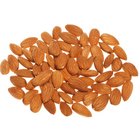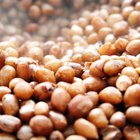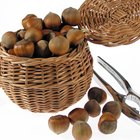
Believe it or not, not all almonds are created equal. While most of us don't give much thought to what kind of almond we consume, there are a number of varieties of this common nut, each of which features particular characteristics. Some of these varieties are natural, while others have been created by scientists in labs.
Nonpareil
Nonpareil almonds are a type of almond created by scientist A.T. Hatch in 1879. This type is quite common, making up, for instance, over half of the crop in California, a major nut producer for the United States. The nonpareil variety yields a high count of almonds and is thus good for trade. These almonds are easy to blanch, with their thin, smooth shells.
Mission
Mission almonds were developed in Texas in the late-19th century and were originally called Texas almonds. These almonds are smaller than other varieties, but come with a thick shell. Mission almonds are also darker than other types of almonds, featuring a brownish-red shell. These almonds have a strong and robust taste; accordingly, they are often used in dessert dishes, including ice cream. Mission almonds are not blanched, since they wrinkle easily.
California
California almonds are actually a class of almond which includes several smaller, versatile varieties of the nut. Each of these varieties is conducive to blanching and features shells that are a bit darker than the nonpareil and of medium thickness. The versatility of these almonds means that they are easily processed, making them popular for manufactured food products as well as consumption on their own.
Carmel
Carmel almonds were originally considered to be a member of the California class of almond varieties when they were first developed in 1966. However, Carmel almonds became more popular and were then given their own classification as a distinct variety. These almonds are soft-shelled and can be both blanched and roasted. They are also easily processed, so they are used in manufactured goods, eaten on their own and can be substituted for other varieties, such as nonpareil almonds.
Related Articles
Almonds Sliced vs. Slivered
Do Almonds Ever Go Bad?

What Kinds of Nuts Don't Grow on Trees?
Calories in Candied Walnuts

Substitute for Peanut Satay Sauce

Type of Peanuts Used to Make Peanut ...

How to Cook Raw Almonds

Are Buckeyes & Chestnuts the Same?

Differences Between Roasted & Raw Nut ...

Good Substitute for Cashews in Raw ...

How to Make Sugared Almonds

Why Do Cashews Cost More Than Peanuts?

What Countries Harvest Pearls?

What Is a Hickory Nut?

How to Eat Hazelnuts

Types of Greek Fruits & Vegetables

Which Nuts Are Alkaline Forming?

Which Country Produces the Most ...

What Is the Difference Between Rolled ...

The Shelf Life of Almond Paste
References
Writer Bio
Harrison Pennybaker began writing in 2004. He has written as a student and a journalist, specializing in politics, travel, arts and culture and current affairs. He holds a Master of Arts in political science and is currently pursuing a Doctor of Philosophy in political science.
Photo Credits
Hemera Technologies/Photos.com/Getty Images